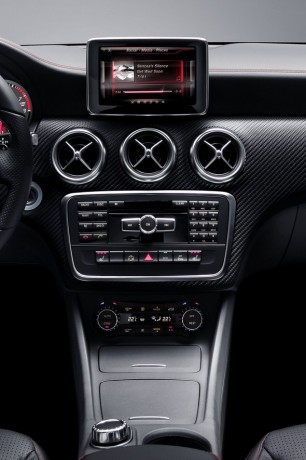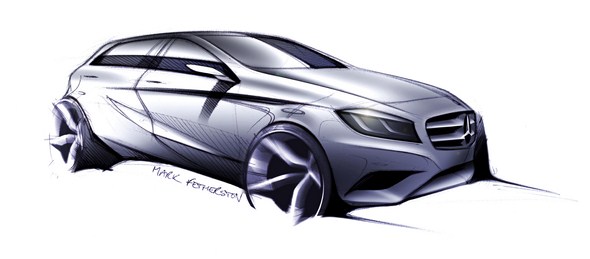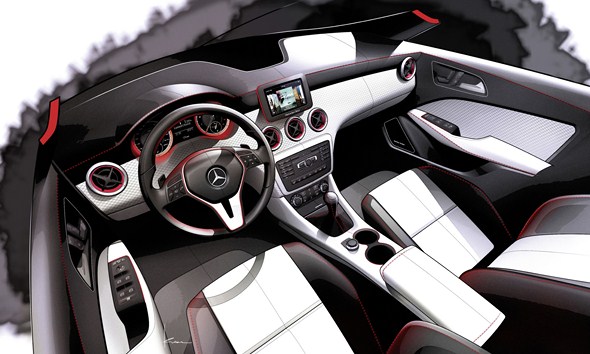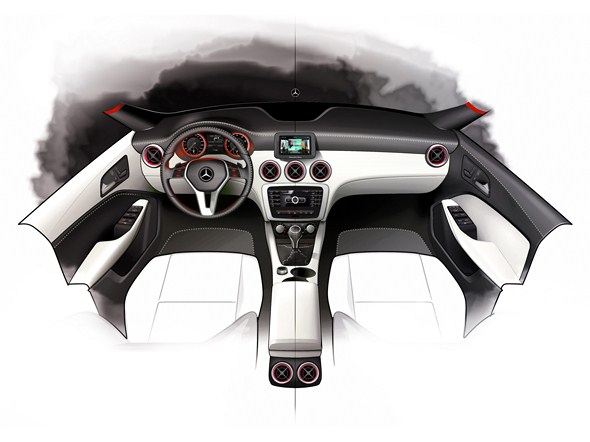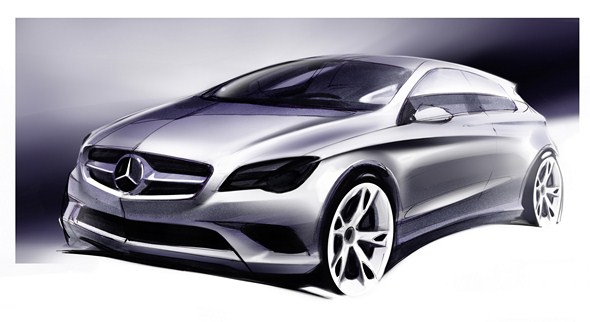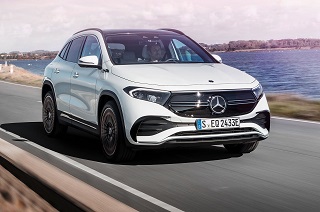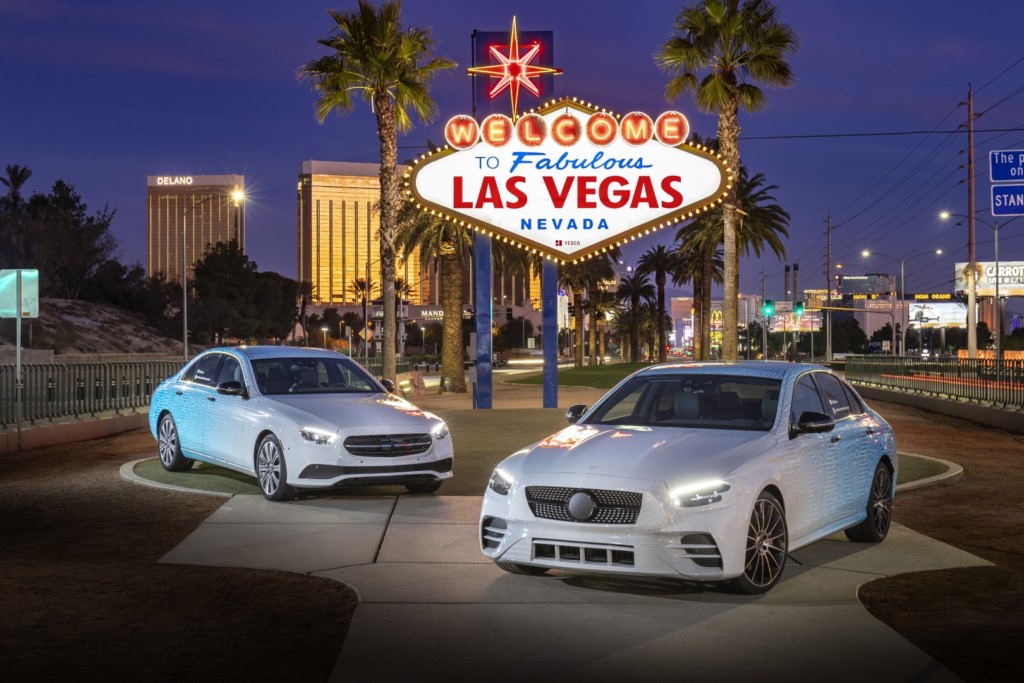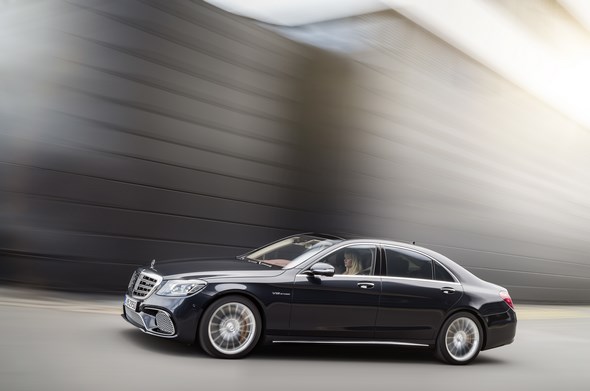The development of the A-Class

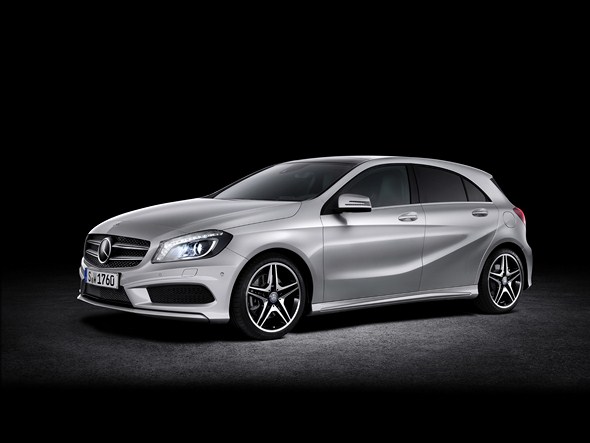
The development of the A-Class: the design
The most progressive design in the compact class
Stuttgart. The pulse of a new generation. The new Mercedes-Benz A-Class caused a furore. Its first presentation at the Geneva Motor Show made headlines: “A” for all perfectly done” (auto motor & sport), “A” as in “all different” (Focus), “Top-class, this “A” (Bild), “A” as in “all new” (Der Spiegel), “Muscular, low, sporty” (AutoBild).
Before the new A-Class rolls on its way to European dealers in September 2012, Mercedes-Benz is to provide – in several instalments – insights into important development steps on its way to its market inauguration. This time the topic is design.
Standing as much as 18 centimetres lower on the street than the preceding model, the new A-Class communicates design and dynamism at the very first glance. This radical form language, presented and enthusiastically acclaimed around the world with the Concept A-CLASS, was consistently implemented in the series production car.
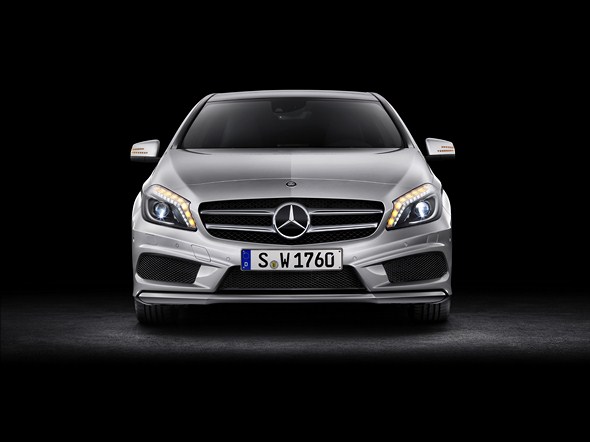
The appearance of the new A-Class reflects this new Mercedes-Benz design strategy. The result is what is known as a two-box design with a distinct character of its own, a sportily emotive exterior and an exceptionally high-quality feel to the interior.
“Translating the new dynamic style of Mercedes-Benz into the compact class was a challenge that was great fun to tackle”, explains Gorden Wagener, Head of Design at Mercedes-Benz. “No other car in this segment is as progressive as the A-Class.
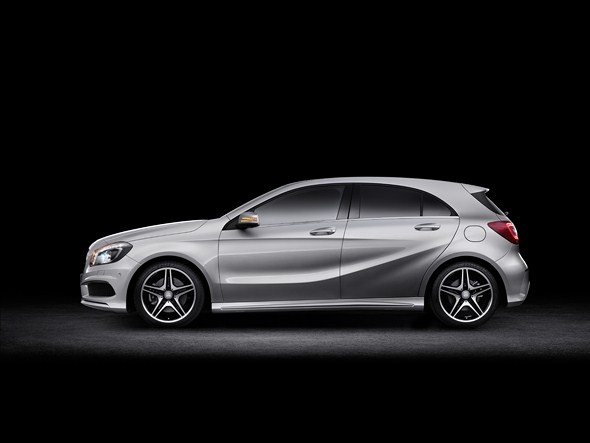
Absolutely typical for Mercedes is the sculptural shape of the A-Class. The character lines, in particular on its sides, lend the A-Class structure and terseness. The new dynamic style is perceptible at first glance in the interior as well.”
Defined edges and tautly drawn surfaces mark out the exterior design of the new A-Class. The constant interplay between concave and convex surfaces creates a characteristic play of light, particularly along the sides of the car, which contributes to its unique appearance.
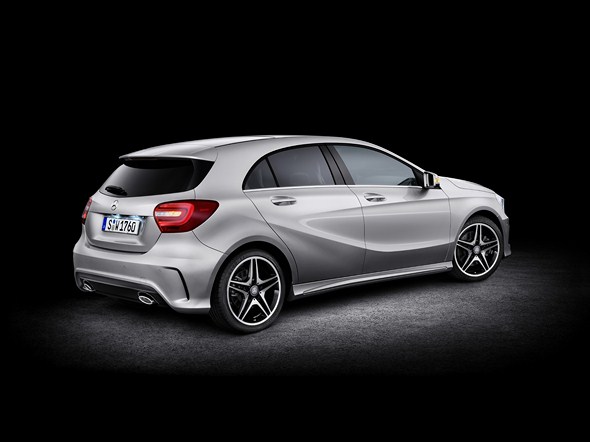
Typical features of the long, sporty front are its pronounced V-shape, the separate headlamps, the radiator grille with central Mercedes star and double slats to either side of the star, as well as the additional air intakes on the sides.
The “dropping line” apparent in the side profile dissipates towards the vehicle’s front end. The design of the headlamps, together with the configuration of the light functions within them, is a key element of the design concept.
The light modules and LEDs behind the headlamp cover glass have been arranged in such a way as to create the characteristic “flare effect” for the daytime running lamps and indicators. The so-called “flare” is made up of the feature line within the headlamp, the LED modules for the daytime running lamps and the bulb sets for the indicators.
This signature effect gives the car its energetic look and so helps to define a new, youthful face for Mercedes.
The perfect interplay of dynamic design and excellent aerodynamics is nowhere more apparent than in the roof, with its smooth surfaces and taut, arcing curve. The silhouette reveals smooth, flowing lines finishing in a flat edge. The roof spoiler, which conveniently hides all the aerials, provides an extra sporty touch and gives structure to the roof assembly.

The beltline rises to the rear to form a pronounced wedge-shape. The side view is distinguished by sensuously moulded sculptural side panels and crisp lines. The front structural edge, above the wing, falls in what is known as a “dropping line” in a gentle arc towards the rear.
The powerfully-shaped shoulder muscles above the rear axle serve to emphasise the car’s coupé-like character. A further line sweeps up from just in front of the rear wheel arch, then gently fades away. All these lines give depth and dynamism to the car’s profile. Dynamic side sill panels provide a final finishing touch towards the bottom of the car, enhancing the appearance of elegant light-footedness.
The broad emphasis of the tail end is revealed in an interplay of convex-concave surfaces and edges. The tail lights continue the line of the muscular shoulders back towards the rear, while their horizontal orientation emphasises the car’s powerful breadth.
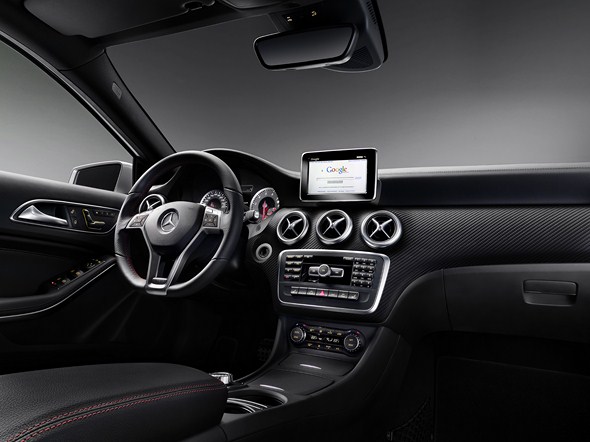
The light functions are provided by fibre-optic cables and LED modules. Here, too, the interaction between design and aerodynamics is very clear: the surface finish of the tail lights is not only an interesting design feature, but also improves the airflow around the vehicle thanks to defined airflow break-away edges in the rear section.
The interior
Extraordinary perceived value
The starting point for the interior design was the interior sculpture “Mercedes-Benz Aesthetics No. 2” presented at the Detroit Motor Show in January 2011 and which directed attention to the new Mercedes-Benz design language in the vehicle interior, too. The first concrete implementation of this was shown in April 2011 with the “Concept A-CLASS” created in the Advanced Design Studio in the northern Italian city of Como.
“The inspiration from aircraft design is continued in the A-Class”, explains designer Jan Kaul. “The instrument panel is clearly divided into an upper part inspired on a wing profile and a muscular lower section. This creates the impression that the upper section is supported by a muscle.”
The process used for the production of the muscle allows diverse soft surface textures. It is thus possible to create different surface appearances with an attractive play of lights thanks to three-dimensional structures embedded in foil.

“The interior of the A-Class represents a big step forward in terms of quality – both in the materials used and in the consistency of the design” says Kaul. Both objectives have been achieved with the help of a specific design idiom and through the various combination options possible with the high-quality materials selected.
All trim elements have been given an electroplated finish, resulting in real metal surfaces with “cool touch” effect. The work has been executed with considerable care and attention to detail, so that they appear to have been moulded in one piece.
The instrument panel incorporates five round vents. “Like brilliant jewels they underscore the superior quality of the vehicle interior”, explains Kaul. The outer rings of the round vents have a high-quality electroplated finish.
The airflow direction is governed by an insert that is reminiscent of an aircraft turbine and reveals a meticulous attention to detail. This too has an electroplated finish in silver-chrome. The free-standing display screen features a black piano-lacquer-look front panel and a flush-fitting silver frame.
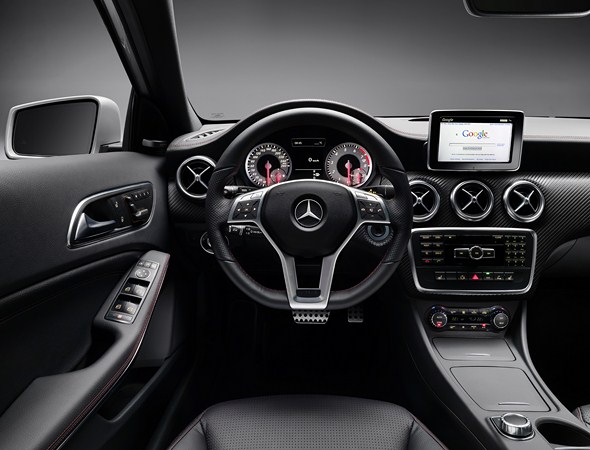
The instrument cluster comprises two large round instruments, each with a small dial set within it. When at rest, the dial needles stand at 6 o’clock. The pointer inlays are in white, although with the sportier design and equipment lines such as Urban and AMG Sport they are in red. The dials on the sporty equipment lines and packages are coloured silver with a chequered flag effect. The 3-spoke steering wheel comes with 12 function buttons and an electroplated bezel.
The centre dome and console, as well as the positioning of the various elements such as the head unit, lower control panel, air conditioning operating unit, stowage compartments, rotary push-button and armrest, reflect the findings of the ergonomics experts at Mercedes-Benz.
An extensive range of seat coverings, in terms of material (e.g. leather, fabric, Artico/fabric), colour combination and also geometry, provides scope for a broad range of individualisation options. Sports seats with integrated head restraints are available, for example, as an optional extra with all design and equipment lines.
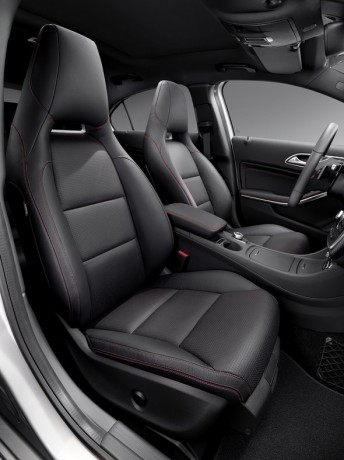
The sporty nature of the seats is emphasised by the opening between the upper edge of the seat backrest and the head restraint. On the back of the front seats this opening is edged with a frame in silver chrome and, in conjunction with the Light and Sight package, can also feature ambient lighting.
Designer Jan Kaul sums up: “If you were to take a seat in the A-Class with your eyes closed – you would never think, upon opening your eyes, that you were sitting in a compact-class vehicle.”
Interview: Mark Fetherston, A-Class designer
“The A-Class puts an end to boredom in this segment”
Mark Fetherston (35) earned his graduate degree in Transport Design at Coventry University in 1999. Since then he has worked at Mercedes-Benz, most recently on the design of the SLS AMG super sports car.
Mr Fetherston, did you have to overcome particularly great resistance in the company in order to implement series production of the expressive, emotional design of the new A-Class, which does break with some preconcepts towards the brand?
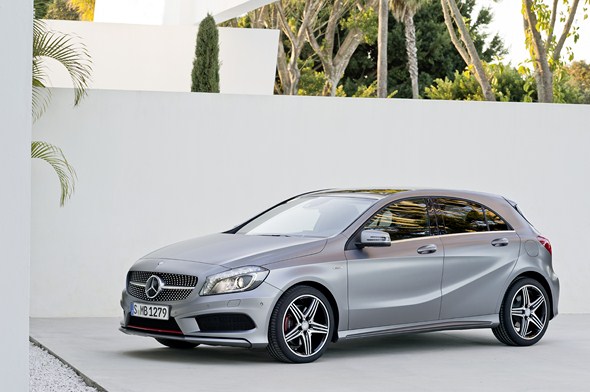
Fetherston: to be quite honest – at first I wouldn’t have imagined that at Mercedes we would dare to build such a car. But the Board gave us wide-ranging freedom in respect of the design of the A-Class. Indeed, they even encouraged us to be more progressive.
If you are so clearly breaking new ground – what is it that makes this new A-Class a true Mercedes, then?
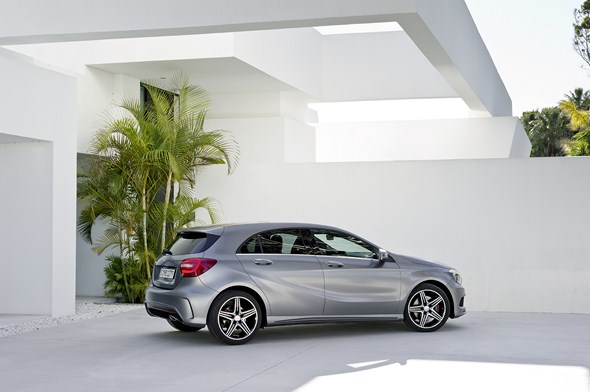
Fetherston: the sculptural quality of the A-Class’s form is typically Mercedes. This traditionally distinguishes Mercedes-Benz from other brands. We made the A-Class sculpture in clay by hand – you can’t do this on the computer.
Look for instance at the muscular shape of the shoulder above the rear axle. The character lines, in particular on the vehicle sides lend this sculpture structure and terseness. The Dropping Line is an elegant link to the Mercedes heritage, the high side sill line provides dynamism. The A-Class is a clear statement of the dynamism of the Mercedes-Benz brand.
Most recently you designed the modern SLS AMG gullwing. What is more difficult to design – a supersports car or a compact-class Mercedes?
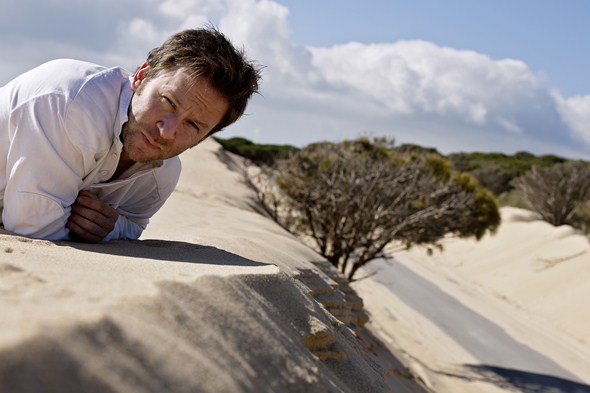
Fetherston: in terms of dynamics, a super sports car is easier to design – because its proportions are intrinsically dynamic. But that is precisely why the challenge of implementing the sporty dynamics of Mercedes-Benz in the compact class was such fun.
And apart from the SLS super sports car, what else served as inspiration in the first design phase?
Fetherston: Nature itself is a very important source of inspiration; take for instance the way the wind sculpts sand into sand dunes – magnificent. One can also observe beautiful shapes in winter landscapes. I love aircraft, too. One of the greatest designs of all times is the Concorde – sheer aerodynamics.

And even though it may seem a bit like a cliché – when you see the A-Class from the front, you can be reminded of a wild cat, a lion or a cheetah. Aggressive and sleek.
We thought of another likeness when we saw the A-Class for the first time: in the compact-car segment, the new A-Class is like the face in the crowd…
Fetherston (laughs): Yes, no other car is so progressive in this vehicle class. The A-Class puts an end to boredom in this segment.
The Mercedes-Benz design philosophy
Design as a trademark
To create fascination and brand identity: that’s the objective of the Mercedes-Benz design philosophy, oriented towards long-term effect rather than short-lived trends, it taps into a “gene pool” of brand-typical style elements in the sense of a living tradition. At the end of this process is the car as an individual space for living.
For Mercedes-Benz, design is literally a trademark. Because for over 100 years, design has characterised the image of the brand with the three-pointed star and has made visible typical Mercedes brand values such as fascination, responsibility and perfection.
Insofar, design has important tasks on two counts – and Mercedes design has fulfilled them for many years now very successfully: the car’s lines fascinate not only because of the product itself, they also serve as a mirror of the philosophy and profile of the Stuttgart-based automotive brand. In other words: design makes brand values visible – and sets its mark on them.
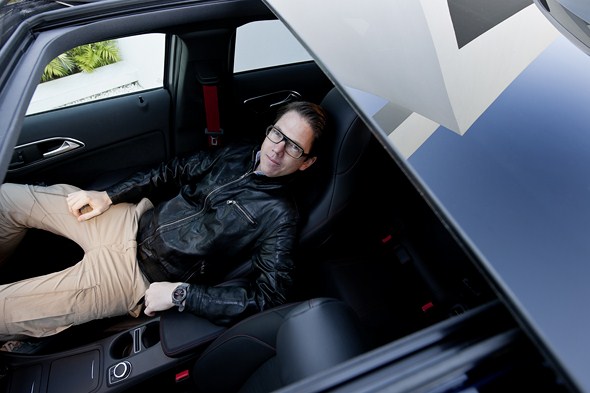
Design should also awaken passion, passion for the automobile and the wish to possess a model. “Love at first sight” has long been a slogan with a great reality content in the automotive trade. After arousing love at first sight, one of the main tasks of the designers is to create a lasting relationship and maintain the love affair over many years.
The psychological arc goes from acquaint to recognise to brand awareness. It is not only a question of creating shapely, functional individual products, but of generating brand identity at the same time.
Identity and continuity
However, in order to build up and care adequately for such a successful brand image, long-term strategies and conceptual continuity are essential. New Mercedes models must indeed formally create a bridge to the future, but at the same time their lines may not abandon their origin.
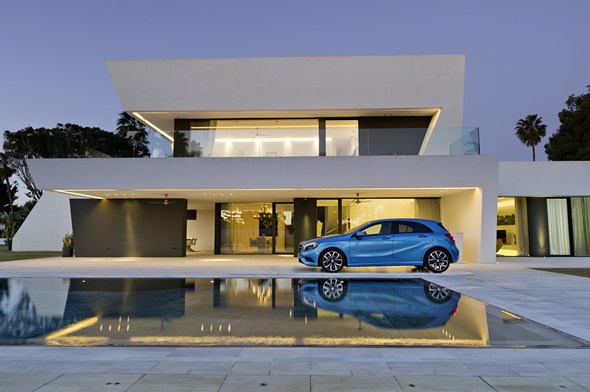
This guarantees that every new Mercedes-Benz possesses a clearly recognisable identity and shows its pedigree at the first glance. Although every model displays unmistakeable analogies with its predecessors, it shows a clear formal further development and heralds a new design era.
Given that a product life span of around 20 years is quite realistic for Mercedes automobiles, the designers must not indulge in passing fancies. The high market value which Mercedes-Benz passenger cars retain even after many years on the road is due not least to the fact that a previous model of Mercedes-Benz does not automatically “look” old.
Even when new models come out in a model series, they don’t detract from their predecessors, which continue to be desirable, in particular because of the enduring appeal of their design.
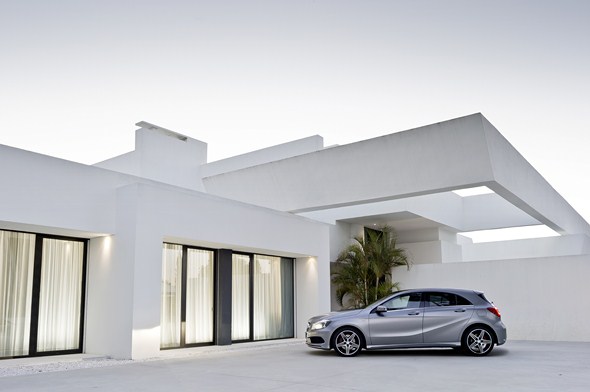
A Mercedes-Benz is always recognisable as a Mercedes-Benz. Meticulously and with great care, Mercedes-Benz designers ensure that certain style features, while being further developed, are retained in their basic form. Designers then speak of the brand’s “gene pool”. This is what they tap into, to care for and protect the style of the brand.
A good example of this is the typical Mercedes radiator grille – a feature which has identified and rendered unmistakeable the motor car with the three-pointed star for over 100 years. Over this long span of time the radiator grille has been repeatedly developed further in a formal sense. Both in its basic proportions and in its details the designers try to interpret this identifying feature anew, creating a fresh, modern image.
This principle also applies for the sporty counterpart, the so-called SL radiator, which was directly derived from racing in the 1950s and has since become a symbol not only for Mercedes sports cars, but also for the refined sportiness which finds its expression in many model series. In the same manner as the saloon radiator, this element is also constantly being newly interpreted in the formal sense.

Through this detail work, form language and brand image retain their vitality, remain innovative and dynamic, but at the same time unmistakeable.
And yet an all-too-strict interpretation of the striving for formal continuity entails the risk of running into a stylistic dead-end alley, where there is no room for individuality. There is no such formal monotony at Mercedes-Benz; on the contrary: every model – whether it is a luxury saloon, a coupé, a roadster or a compact-class car – presents itself as an independent “personality”.
The common, well-known basic patterns of the form language are combined with new style elements that at first appear surprising, yet in conjunction with familiar elements condition, ever anew, the perception of the Stuttgart-based automotive brand.
Trends and reality
Recognising and shaping trends are important tasks of the auto designers. They live in the present, but their realm of action is the future. This calls for a very sensitive perception for changes in customers’ life habits, for people’s new attitudes towards their daily life and for those tendencies concerning form and colour made evident in other sectors such as the furniture industry or the electronics sector, for example.
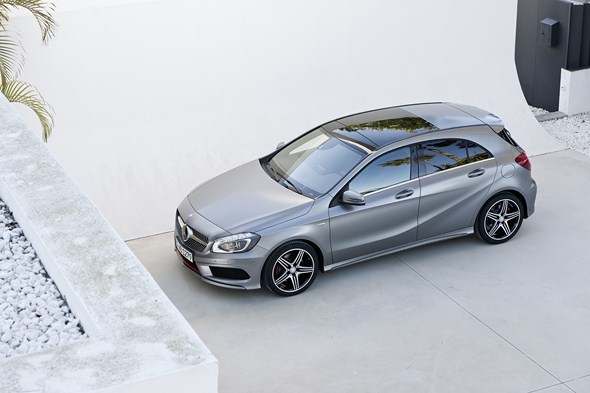
Or for impulses coming from other cultures; this is why Mercedes designers do not only work in Germany, but in Italy, Japan, China and the USA as well. The automaker has set up Advanced Design Studios at all these locations, to act as a sort of seismograph and pick up stylistic trends on site and analyse them to process them creatively.
A key issue here is the ability to intuitively grasp that which can attain formal timelessness, and to develop a sensitivity for important, sustainable tendencies in art, culture and society.
However, having a vision for the future and being able to sense new trends is not enough. Because behind the manifold, diffuse wealth of future ideas on offer there lies the question of which of the currents does a brand like Mercedes-Benz want to allow itself to be influenced by. For Mercedes-Benz it has always been decisive to be, not fashionable, but modern.

That’s why what is important is to distinguish between short-lived tendencies and long-term developments and thus identify customers’ authentic expectations for the future. Mercedes designers therefore do not need trend counselling but rather a well-founded prognosis and concrete answers to the questions as to how people will live tomorrow, how they will consume and – in particular – how to enthral and inspire future customers.
The challenge consists in reflecting about possible future developments and to think further – beyond the reality that bears the seal of trends and fashion.
Passion and practicality
This aspect is probably the most important and interesting of those that determine the work of automotive designers. It is all about people, or, more specifically, about customers and their personality. Because driving a car today means a lot more than reaching your destination in safety and comfort.
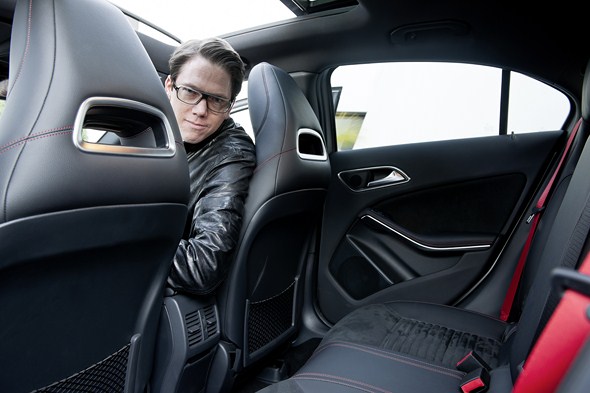
Today, more than ever, the emphasis is on making the journey itself an experience that is enjoyable because one feels at ease in one’s car, and because the car goes well with one’s lifestyle – and because it is also possible to express style very well by means of the car. More than ever, the sensory perception of a product therefore plays an exceptional role.
Experience and enjoyment
Keeping the fascination for what is beautiful alive over the years is also one of the most important tasks of the interior designers. Its importance for design work is increasing. The interior of a car is conceived as a space for living, one where a lot of time is spent. That is why a pleasant environment is playing an increasingly important role in the motor car, too.

There is no doubt about it: customers have become both more demanding and more discerning over the years in this respect. They not only want a wide choice of possible appointments from which to pick precisely that which suits their individual taste and personality.
They now also set greater store by the use of high-quality materials and precision workmanship. These of course help convey, whilst also making more tangible, values such as aesthetics, comfort and quality as part of the overall visual impression.
The objective of the interior designers at Mercedes-Benz can be summed up in a few words: one gets into the car, closes the doors and immediately feels at home.
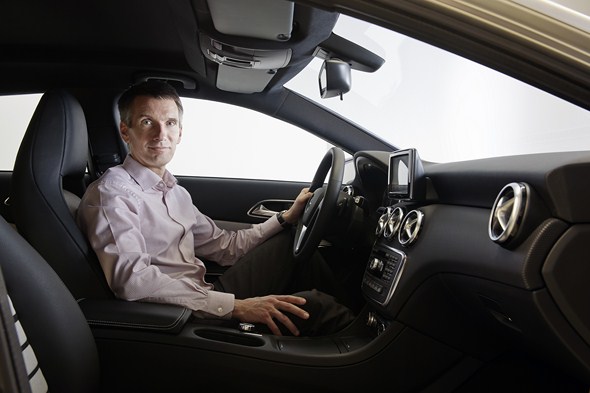
Form and function
But for all their love and attention to detail: automotive designers are not packaging artists. It is by no means their task to simply pack new technologies or new vehicle concepts into a handsome form – they contribute decisively towards initiating new ideas and help them on their way to series production.
The entire Mercedes-Benz strategic product initiative documents just how closely product strategy, design and technology work together at the Stuttgart-based automotive brand.
Mercedes designers are integrated right from the start in the concept phase and in the development process of new models. That also means: design work is team work; the design studio of a large-series manufacturer is not a dream factory.
In a team both designers and engineers have to be ready to make compromises in order to find viable solutions that meet all the requirements. This poses harder challenges for automotive designers than for their colleagues in other industrial sectors.

The motor car is one of the few industrial products from which the customer expects not only a handsome exterior, but also a
perfectly-designed interior as well. In addition to this, the car is a product made up from different individual areas. Many of these details are quite as complex as entire devices produced in other industrial sectors.
Function and aesthetics, technology and art: what at first sight sounds contradictory has to blend into a harmonious overall concept in a modern car. The objective has been attained if design work and the engineering arts complement each other on a sophisticated level.
Thus, practicality and good design are not natural enemies. Technological leadership is an integral part of the brand philosophy and it is the task of design to make this mission visible, while setting trends in its own way.
Visions and emotions
This is what show cars, concept and research vehicles are also for. They are conceived and developed in order to impulse auto-visions, to test new vehicle concepts and technologies, to intensify the dialogue with customers and also to analyse the public’s reaction to these auto-ideas.
Mercedes-Benz also carries out such auto-studies in order to take a look at the future in respect of stylistic developments and to offer designers a possibility to develop and implement new form languages.
But whether a unique research vehicle or series-produced – a motor vehicle is always perceived with one’s senses. No-one can evade its emotional effect. Long before one has any idea about the relevant technical facts or innovations, through its mere appearance – that is, through its design – it awakens desires.
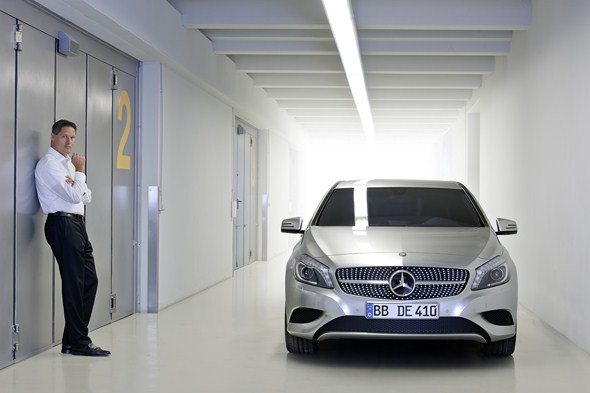
It is the responsibility of the designers to awaken and keep alive these emotions. The goal of their work is to create automobiles in the field of tension between technology and design, that are characterised both by technical and emotional intelligence.
The designers’ work is a success if customers buy cars not only for purely rational reasons but also with their heart – and mind.
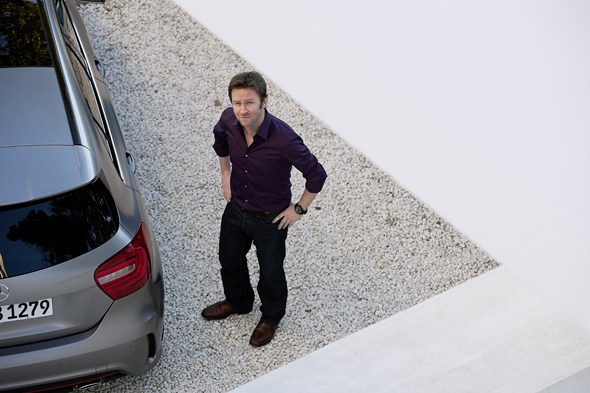
The Advanced Design Studio in Como/Italy
Tracking down new interior design trends
Integrated in the global Mercedes Design network, the designers at the Advanced Design Studio in Como find an inspiring environment for creative thoughts.
Always a good address: in the Villa Salazar near the shore of Lake Como, Italian fashion designer Gianni Versace used to produce bowties and neckties, before Mercedes-Benz opened the Advanced Design Studio here in February 1998.
With its contemporary ceiling paintings, long corridors and different terracotta and wooden floors, the villa, built around 1750, is exceptionally inspiring for the around 20 designers who work here. This also holds true for the region itself: the famous triangle between the cities of Como, Milan and Turin is a centre of fashion and the furniture industry.
Traditional crafts are highly valued there – an ideal environment for the Advanced Design Studio.

With its sister studios in Carlsbad (California), Tokyo, Beijing and Sindelfingen, the Advanced Design Studio in Como not only exchanges ideas, but also creative people. Gorden Wagener, Head of Design at Mercedes-Benz, is responsible for all the Studios.
Apart from the approximately 440 designers who take care of the series production vehicles, at the five Advanced Design Studios over 60 designers work on the concepts that have enabled the brand with the three-pointed star to look up to a quarter of a century ahead into the future.
A variety of inspirations flow into the concepts for the vehicle interior design – because this is what the Advanced Design Studio in Como has specialised in. Designers can allow their thoughts free rein without immediately having to think of series production.
The latter is, of course, the final goal of the ideas and reflections. With the so-called “appreciation model” the designers first implement their ideal conceptions and then look for a way to translate these ideas to series production. This allows for a more consistent and higher-quality result than what would be obtained by upgrading the vehicle interior subsequently.
The tasks of the creative professionals in Como are numerous. They carry out normal research, develop drafts and build models – and always look beyond the horizon in order to develop the automobile interior of the future. A certain fine disregard for old conventional rules is desirable in order to find fresh approaches.
“We don’t chase after fashion phenomena”, says Gorden Wagener, Head of Design at Mercedes-Benz, “we detect long-term trends which raise the value of our brand over the decades. Ideas which fulfil the highest requirements in terms of technology, performance, comfort and safety.” A designer therefore has to “live in the future” and think two to three vehicle generations ahead of their time.
One of the first visible and tangible results produced by the Advanced Design Studios in Como was the interior of the Mercedes-Benz F 400 Carving research vehicle (Tokyo 2001). In 2002 the Vision GST, a forerunner of the Mercedes-Benz R-Class, followed in Detroit; 2003 saw the debut of the F 500 Mind research vehicle (Tokyo).
In 2005 saw the public appearance in Washington of the Mercedes-Benz bionic car, and the F 600 HYGENIUS in Tokyo. The Mercedes-Benz F 700 research vehicle presented in 2007 featured an interior design based on cork and Alcantara®.

In 2011 Mercedes-Benz presented the research cars F125! and F800 Style as well as the Concept A-CLASS; all three featured interior appointments from Como. Many unusual details of the Concept A-CLASS take their cue from the realm of aviation.
Diverse components were restructured: the instrument panel and the centre console, for instance, consist only of a complex brushed aluminium structure. The result is a transparent, light, bionic forming.
The work methods of Mercedes-Benz Design
Eleven steps to a finished automobile
The path leading from the first drawing to the model approval takes around three years. In this time a Mercedes goes through an endless series of work steps in the course of which the designers, so to say, grope their way little by little to the final vehicle. From previously competing drafts, the team produces the next generation of a Mercedes-Benz.
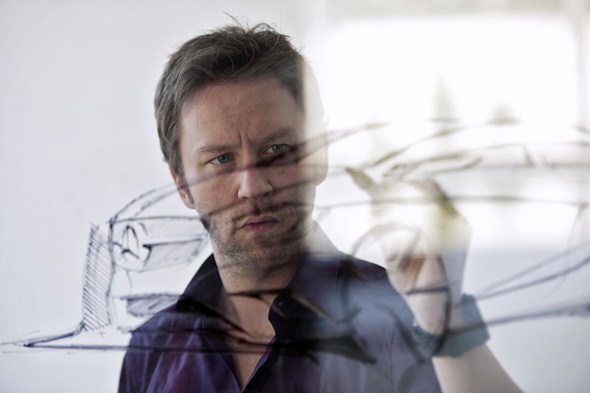
- Drawing/Rendering: at the beginning of the design process there is always a drawing – hand-sketched on a piece of paper, or on a screen. Ideas that had previously only existed in the designer’s mind become visible.
- Package: the basis for every design is the package, the sum of all the technical requirements. This is the basis upon which the sketches have to be implemented in such a way that proportions, dimensions and
lines give a harmonious image. - 1:4 clay model: not everything can be simulated on the computer, which is why the next step is to create a clay model of every variant of a new automobile. Only then can the designers decide whether their drafts create the desired effect in three dimensions, too. At the same time virtual models are always created on the computer.

- Model selection: the final form of the new car is chosen from numerous variants, in order to be formally examined in a 1:1 scale. With the help of scanning and milling machines the first full-size
“prototypes” are made.

- 1:1 model: all the individual details of the new model are fashioned by hand. A deceptively real-looking model is created. All the characteristic features of the new car reveal themselves.
- Interior sketches: first drawings and renderings are created for the design of the interior. This is when the different equipment lines are born, i.e. the interiors where the future driver has to feel at ease.

- *The leit motif here: “Perfect aesthetics” – a design that feels committed to beauty.
- Interior clay model: the best way for the designer to experience the development of the form is with a 1-in-1 clay model, built, so to say, from the inside out. All the details are modelled until an aesthetically top-quality spatial feeling is created. As a rule, three alternative interiors are built for a decision to be made.
- Colour & trim / operating and display concept (control and display system): the material and colour options for the vehicle interior are determined. From hundreds of fabric and leather samples as well as a virtually endless colour spectrum the equipment variants for the future motor vehicle are determined. All the control and display elements are designed and developed to the optimum.
- Interior data control model: all the materials and colours are tested for effect on sophisticated 1-in-1 interior models under “real-life conditions”. Every material and every colour receives a code and is specified.

- Final model: the exterior and the interior with all their details are brought together to make a model. A deceptively realistic representation is created. All the characteristic features of the new car reveal themselves. The exterior shape of the future Mercedes-Benz model becomes tangible.
Model approval: The final point of every design process is the model approval by the Board. If this is successful, there is nothing more to stop the production of the new Mercedes-Benz.
